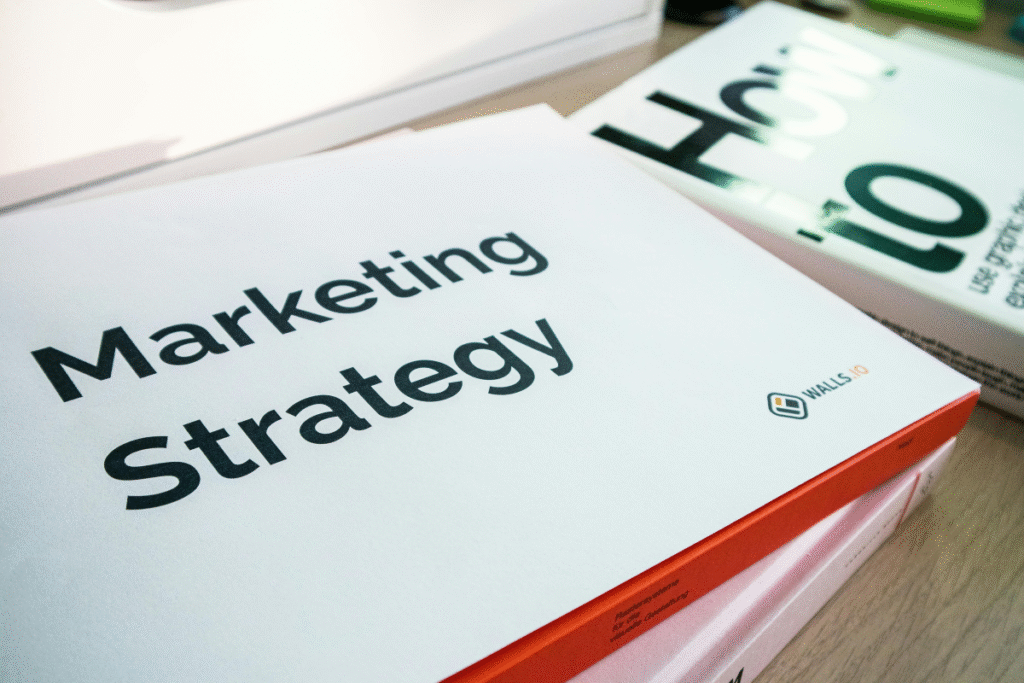A clear plan helps your business grow. It shows people who you are and what you offer. Start by building a website. This gives people a place to learn more about you.
Your social pages say a lot about you. They matter just as much as your website. Keep your tone and look the same across every platform. People notice when things don’t match.
If your site feels calm and friendly, your Facebook or Instagram should feel the same way too. Then, use tools like SEO, PR, and influencer posts. These help you get more visits and leads without spending much. This guide shows you what to do, why it matters, and how to get started.
Key Points
- Use a step-by-step plan to turn your idea into a brand.
- Learn to reach the right people with the right message.
- Track what works so you can do more of it.
What Is a Marketing Strategy?
A marketing strategy is a plan that helps you sell your product or service. It helps you find your audience, build trust, and reach your goals. Every business—big or small—needs one.
The plan should match your goals, your customers, and your type of work. A brand is not just a nice design or fun slogan. It’s how people feel when they see your name.
It includes your message, your look, and how you treat your customers. It’s also shaped by what others say about you. To build a good brand, be clear and stay consistent.

Start With the Basics
Here’s what your strategy should cover:
- What are your goals (more sales, more signups, more traffic)?
- Who are your customers? Where do they live or work?
- What do they want or need?
- Who are your top competitors?
- What makes your product better?
- What’s the one message people should always remember?
Repeat that message everywhere on your website, in your posts, and in your ads.
Example: How Airbnb Grew
Airbnb asked guests to post travel photos with the tag #Airbnb. People shared pictures and stories. This made the brand feel real and trusted. It showed happy guests and homes in real places. The campaign cost little but made a big impact.
Why You Need a Marketing Plan
When you start a business, you need customers fast. Many people try everything—ads, posts, flyers, emails. Most of it fails. Why? No plan.
A good plan saves time and money. It helps you stay focused and reach people who care.
This guide shows five clear steps. It’s for small business owners, side hustlers, or anyone new to marketing.
Why You Need a Strategy
A strong strategy helps you:
- Get more people to notice your brand
- Build trust with new and old customers
- Stand out from other businesses
- Send more people to your website or shop
- Reach your business goals, like more sales
A strategy is your big-picture idea. It shows what you want and how to get there. It helps you spot risks and plan ahead. A plan gives the steps. It tells you what to do each day and how to track results.
Use the 4 Ps
A full plan should also cover:
- Product – What you sell
- Price – What it costs
- Place – Where to buy it
- Promotion – How people hear about it
Use the same message everywhere. That helps people remember you.
5 Simple Steps to Build a Marketing Strategy
Step 1: Set Goals You Can Measure
Goals help you stay on track. They guide every move you make.
Start small. Pick one or two goals. Make them clear and easy to track. Like these:
- Get 100 email signups in 30 days.
- Book 10 calls with leads this month.
- Sell 50 products by the end of the month.
Don’t just say, “I want more sales.” Say how many. And by when.
Use the SMART method:
- Specific: Clear and focused
- Measurable: Track progress
- Achievable: Make it realistic
- Relevant: Tied to your business
- Time-bound: Set a deadline
Fact: Marketers with clear goals are 376% more likely to succeed (CoSchedule).
Step 2: Know Who You’re Talking To

If you know your customer, you’ll know what to say and where to say it.
Ask yourself:
- Who is my ideal customer?
- What problems do they have?
- What are they using now?
- Why would they switch to me?
Build a quick profile (called a buyer persona):
Example:
- Name: Maya
- Age: 32
- Job: Freelancer
- Problem: Can’t track client work well
- Goal: Wants to stay on schedule
Where to find this info:
- Google Trends
- Reddit or Facebook Groups
- Quora
- Ubersuggest
Tip from Neil Patel: Even five survey replies can help you know your audience.
Step 3: Pick the Right Channels
Don’t use every platform. Use one or two that your audience already uses.
Here are some options:
- SEO: Good for getting traffic over time
- Email: Best for staying in touch
- Instagram or TikTok: Good for visuals
- Facebook Groups: Great for trust
- LinkedIn: Best for B2B or services
- YouTube: Good for how-to content
How to choose:
- Use SEO if people search for your product
- Use Instagram if your product looks good
- Use email if you want to build trust
Example:
A bakery used Instagram Stories to post daily specials. In three months, foot traffic doubled.
Step 4: Create Clear Messages
Once you know your customer and platform, plan what to say. Good marketers test. Great marketers learn from tests. Start with your value statement:
Format:
“I help [who] get [what] using [how].”
Example:
“I help salons get more bookings by managing reviews and listings.”
Tips:
- Talk about real problems
- Use simple words
- Keep the same voice in all your posts and emails
Step 5: Test, Track, and Repeat
See what works. Then do more of that.

Track things like:
- Website traffic
- Email open rates
- Social clicks
- Leads and sales
Tools to use:
- Google Analytics
- Mailchimp or MailerLite
- Buffer or Hootsuite
Pro Tip: Let each campaign run 2–3 weeks before changing it.
Fact: A/B testing subject lines can boost results by 49% (HubSpot).
Some Helpful Tools and Visuals
- Flowchart: Simple map from idea to brand
- Comparison Table: Shows channel cost and effort
- Persona Sheet: Fill in your customer profile
- KPI Tracker: Log results weekly in Excel
Frequently Asked Questions About Building a Marketing Strategy
1. What is a marketing strategy?
A plan that shows who to reach, what to say, and how to measure results.
2. How do I choose the best channel?
Go where your audience already spends time. Start small, then test.
3. Do I need a big budget?

No. SEO, email, and social media can all be low-cost.
4. When will I see results?
Some things work fast (like ads). Others take months (like SEO).
5. What should I track first?
Start with traffic, email opens, and sales.
6. What tools should I use?
Try:
- MailerLite (email)
- Canva (design)
- Ubersuggest (keywords)
- Buffer (social posts)
- Google Analytics (web traffic)
7. Can I start without a website?
Yes, but it helps to have one. Use Wix or Carrd to start cheap.
Final Words
You don’t need a fancy plan. You just need a clear one.
Start with one step at a time:
- Set goals
- Know your audience
- Pick your platform
- Say something real
- Track your work
Every big brand started small. Now it’s your turn.